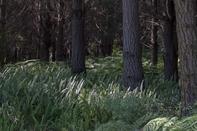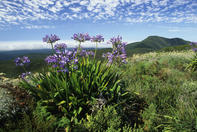European Foresters and Their Alien Trees

Early foresters in the Cape were faced with three main tasks: to establish fast-growing timber plantations to replace the denuded natural forests of the area, to stabilize the wide tracts of shifting sands of the Cape Flats and along the coast, and to grow trees on what they considered to be barren mountain slopes. The first objective was quite easily achieved by planting exotic pines and gum trees. The umbrella-topped stone pine (Pinus pinea) posed few immediate problems, but species like the cluster pine (P. pinaster), being self-seeding, spread into the surrounding mountains where they now pose a great threat to the fynbos.
Alien Invaders
To stabilize the dunes was a task that took much longer to accomplish, but after experimenting with many plants from other Mediterranean areas, Australian acacias proved just the thing. Today Rooikrans and Port Jackson willow (Acacia cyclops and A. saligna) have spread rapidly through the fynbos and indeed frequent veld fires have added their infestation of the natural flora. The third objective was met by giving seeds from Australian hakeas and pines to mountaineers to sow as they walked. It took time for the plan to reach fruition, but today hakeas and pines are so well established in the folded mountains that the state spends vast sums in attempts to control these alien invaders.
Survival is Important

The Cape Floral Kingdom occupies only one percent of Southern Africa, yet it has over 60 per cent of endangered plant species of the sub-continent. Two-thirds of its natural range has been overrun by agriculture and urban expansion and what remains is mainly the Mountain Fynbos which, while being fascinating for its unusual and prolific flowering plants, is the least productive part of the biome which is exactly why it has been left more or less intact.
The need for water and the construction of dams and high level reservoirs in mountain valleys for hydro-electric power are, however, now beginning to threaten even parts of this environment. Disregarding the timber plantations, 24 percent of the remaining Fynbos Biome has been invaded by woody alien species. It would seem that a bleak future awaits the world's smallest and richest floral kingdom, one that has inestimable aesthetic and scientific value, as well as great economic value.
The Fynbos Biome’s survival is necessary for the survival of all its inhabitants. If anything, it will be the wildflower industry of the fynbos area and its potential for high quality water yield that will ensure its conservation and ultimate survival.
Introducing Natural Predators
'Hacking' the hakea is a favourite pastime among conservationists and a regular job for forestry workers, but this barely stems the tide of invasion. The final answer to the invasion problem is to be found in biological controls, with the introduction of natural predators from the invasive plants' countries of origin. The problem with introducing the organisms into the fynbos area is that they too may well invade the natural flora just as their hosts have done.
In the case of the hakea, and some invasive acacias, extensive tests were done with the Australian long-snouted beetle that feeds off the fruit of the plants, to check that it did not develop a taste for the fynbos before setting it free in the Cape mountains. One of the reasons that the Australian plants such as acacias and hakeas fare so well against the local flora is that they were introduced here without their associated predators such as insects, fungi and rodents which would consume their fruits and seed banks. In Australia there is a similar problem with proteas and other plants introduced from the Cape.
Geometric Tortoise
Almost as hard to find as it is beautiful, the geometric tortoise faces extinction because much of its habitat, primarily in the Renosterveld of the Western Cape, has been destroyed. It's also a favourite target of poachers and egg collectors. Head to the reserve at Bartholomeus Klip, which is an hour from Cape Town, to see what the fuss is about.
 The Fynbos Route is situated in the Overberg region of the Western Cape province of South Africa. This route takes you into the hidden corne...
The Fynbos Route is situated in the Overberg region of the Western Cape province of South Africa. This route takes you into the hidden corne... Flower season in the Cape is something magical to behold - Experience the beauty of spring wild flowers on The Cape Flower Season Route....
Flower season in the Cape is something magical to behold - Experience the beauty of spring wild flowers on The Cape Flower Season Route....